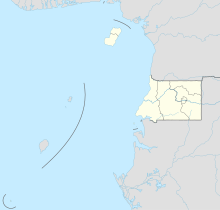Baháʼí Faith in Equatorial Guinea
| Part of a series on the |
| Baháʼí Faith |
|---|
 |
The Baháʼí Faith in Equatorial Guinea begins after
Beginnings
ʻAbdu'l-Bahá's Tablets of the Divine Plan
Establishment of the community
After the initiation of the
The Baháʼí Community in Equatorial Guinea came under the responsibility of the regional National Spiritual Assembly of North West Africa in 1956.
In 1967 in Santa Isabel (later renamed
Growth
Formation of the National Spiritual Assembly of Equatorial Guinea 18 July 1973.[3][15] However, between 1972 and 1979 civil society in the country was under duress and religion was repressed (especially progressively from 1975 to 1979). The national assembly was dissolved in 1975-6 by government action.[15]
The first citizen on Annobón a tiny island of Equatorial Guinea, joined the religion in early 1982.[16] Jose Maria Fierro Cueto (also known as Dr. Pepe), came from Mexico to Equatorial Guinea in the 1980s to assist the Baha'i community.[2] Following a change in government the national assembly was reformed in 1984.[3][4] That same year it was invited to participate as an observer at the first "International Hispanic Congress of Culture" in Bata sponsored by UNESCO. The Baháʼí community also contributed a statement on topics of the congress like of the role of women in society and the importance of education and unity. The congress was designed to define a cultural aim for Equatorial Guinea and to help make that country better known around the world.[17] Joseph Sheppherd was a pioneer to Cameroon and Equatorial Guinea, whose circumstances were woven into a book he later wrote which presents the Baháʼí Faith in a context of global change (see Baháʼí Faith in fiction) and delves into the dynamics of pioneering as a method to gain understanding of spiritual issues compared to social issues, to struggle with a cultural naivete. He served for two years as anthropological adviser to the government and curator of the National Ethnological and Archaeological Museum in Malabo.[18]
Modern community
Since its inception the religion has had involvement in
In 2004 the community celebrates its golden jubilee celebrations.
Baháʼí citizens of Equatorial Guinea were among those to gather in Yaounde, Cameroon, in a conference called for by the Universal House of Justice in 2008.[24]
Demographics
In 2001 Operation World estimated 0.38%, or 1,720 people were Baháʼís—and growing at an annual rate of +4.2%.[25] In 2004 there were four local assemblies in Equatorial Guinea.[2] The Association of Religion Data Archives (relying mostly on the World Christian Encyclopedia) estimated nearly 3,552, or 0.5% of the national population, Baháʼís in 2005.[5]
See also
References
- ^ ISBN 0-87743-233-3.
- ^ a b c d e f g "Obstacles no match for pioneer spirit". Malabo, Equatorial Guinea: Baháʼí International Community. 21 August 2004. Retrieved 30 July 2010.
- ^ a b c d e f Dr. Ahmadi. "Major events of the Century of Light". A Study of the Book "Century of Light". Association For Baháʼí Studies in Southern Africa. Archived from the original on 17 May 2008. Retrieved 17 November 2008.
- ^ a b Hassall, Graham. "Notes on Research on National Spiritual Assemblies". Research notes. Asia Pacific Baháʼí Studies. Retrieved 31 July 2010.
- ^ a b "Most Baha'i Nations (2005)". QuickLists > Compare Nations > Religions >. The Association of Religion Data Archives. 2005. Archived from the original on 23 January 2016. Retrieved 4 July 2009.
- ^ ʻAbbas, ʻAbdu'l-Bahá (April 1919). Tablets, Instructions and Words of Explanation. Mirza Ahmad Sohrab (trans. and comments).
- ISBN 0-87743-233-3.
- ^ Compiled by Hands of the Cause Residing in the Holy Land. "The Baháʼí Faith: 1844–1963: Information Statistical and Comparative, Including the Achievements of the Ten Year International Baháʼí Teaching & Consolidation Plan 1953–1963". pp. 28, 55.
- ^ Hassall, Graham. "North West Africa". Baháʼí Communities by country: Research Notes. Baháʼí Academic Library Online. Retrieved 30 July 2010.
- ^ House of Justice, Universal (1976). Wellspring of Guidance, Messages 1963–1968. Wilmette, Illinois: National Spiritual Assembly of the Baháʼís of the United States. pp. 15, 72.
- ^ "Overview of World Religions". General Essay on the Religions of Sub-Saharan Africa. Division of Religion and Philosophy, University of Cumbria. Archived from the original on 9 December 2007. Retrieved 16 April 2008.
- ^ "International News Service". Baháʼí News. No. 443. February 1968. p. 20.
- ^ "New Communities in West Africa". Baháʼí News. No. 456. March 1969. p. 5.
- ^ "International News Briefs; Equatorial Guinea". Baháʼí News. No. 456. June 1969. p. 5.
- ^ a b Messages from the Universal House of Justice 1963–86 p. 254, 322, 477
- ^ "The World; Cameroon". Baháʼí News. No. 456. August 1982. p. 12.
- ISSN 0195-9212.
- ISSN 0195-9212., see also. Art history museums of the world. artschool.com.ru. 19 March 2008. Retrieved 31 July 2010.
- ^ a b Momen, Moojan. "History of the Baha'i Faith in Iran". draft "A Short Encyclopedia of the Baha'i Faith". Bahai-library.com. Retrieved 16 October 2009.
- ^ Kingdon, Geeta Gandhi (1997). "Education of women and socio-economic development". Baháʼí Studies Review. 7 (1).
- .
- ^ "In the Field: Some Examples". Social & Economic Development. Baháʼí International Community. 2010. Retrieved 31 July 2010.
- ^ "Around the World, Baháʼí Women's Groups Increase Their Activities". One Country. 1997 (April–June). Baháʼí International Community. Archived from the original on 8 April 2010. Retrieved 31 July 2010.
- ^ "The Yaoundé Regional Conference". Regional Conferences of the Five Year Plan. Baháʼí International Community. 29–30 November 2008. Retrieved 31 July 2010.
- ^ "Republic of Equatorial Guinea for May 1". Operation World. Paternoster Lifestyle. 2001. Archived from the original on 4 June 2009. Retrieved 31 July 2010.


